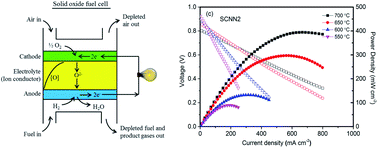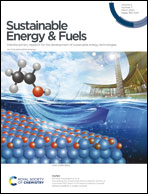A highly active and stable cathode for oxygen reduction in intermediate-temperature solid oxide fuel cells
Abstract
Developing a new low-cost and high-performance oxygen reduction electrode has been an imperative assignment for the development of intermediate temperature solid oxide fuel cells (IT-SOFCs). Herein, a new family of SrCo0.9−xNb0.1NixO3−δ (SCNN, 0.1 ≤ x ≤ 0.3) perovskites have been developed as a promising cathode for IT-SOFCs with improved cathode attributes with respect to their parent compound, SrCo0.9Nb0.1O3−δ (SCN). Partial Ni substitution enhanced the oxygen reduction reaction (ORR) activity for SrCo0.9−xNb0.1NixO3−δ. The SrCo0.7Nb0.1Ni0.2O3−δ (SCNN2) cathode exhibited a polarization resistance of 0.066 Ω cm2 at 700 °C in air, 44% lower than that of SCN. The remarkable ORR catalytic activity for SrCo0.9−xNb0.1NixO3−δ could be ascribed to the improved oxygen bulk diffusion and surface exchange coefficient arising from the introduction of oxygen vacancies with Ni doping according to electrical conductivity relaxation (ECR) and thermogravimetric analysis (TGA) results. Furthermore, the SCNN2 cathode demonstrated excellent stability in air and high CO2 tolerance and recovery performance, demonstrating that the SCNN2 perovskite can be a very promising cathode for application in IT-SOFCs and other energy transformation systems.



 Please wait while we load your content...
Please wait while we load your content...